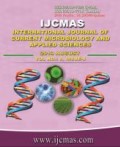


 National Academy of Agricultural Sciences (NAAS)
National Academy of Agricultural Sciences (NAAS)

|
PRINT ISSN : 2319-7692
Online ISSN : 2319-7706 Issues : 12 per year Publisher : Excellent Publishers Email : editorijcmas@gmail.com / submit@ijcmas.com Editor-in-chief: Dr.M.Prakash Index Copernicus ICV 2018: 95.39 NAAS RATING 2020: 5.38 |
Blood stream infections are mainly caused by multi drug resistant organisms which more likely prolong the hospital stay and leads to increased health care costs. Hence, early diagnosis and treatment with appropriate antibiotics is the only way to treat bacteraemia. To study the bacteriological profile of the organisms causing septicaemia and their antibiotic resistance patterns to guide the clinicians to initiate the empirical therapy. Blood samples were collected aseptically from patients before taking any antibiotics. Samples were inoculated into Brain heart infusion broth and incubated at 37 degree for 24 hours. Blind subculture was done on to fresh 5% sheep blood agar and MacConkey agar. A negative result was followed up by examining the broth daily and doing a final subculture at the end of 7th day organisms identified by colony morphology and standard biochemical tests. A total of 273 blood samples were analysed, out of which 50 yielded growths (18.3%). Among this, 49 (98%) yielded bacterial isolates and 1 (2%) was Candida species. Out of 49 bacterial isolates, 28 (56%) were Gram positive organisms and 21 (42%) were Gram negative organisms. Among Gram positive isolates Coagulase negative Staphylococci (36%) were the predominant isolates. Among the Gram negative organisms, Escherichia coli (22%) were the predominant isolate. The incidence of blood stream infection was 18.3%. Majority were bacterial isolates. Gram positive were more than gram negative. Among Gram positive isolates. Coagulase negative Staphylococci (36%) were the predominant isolates. Among the Gram negative organisms, Escherichia coli (22%) was the predominant isolate
 |
 |
 |
 |
 |